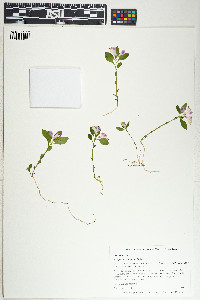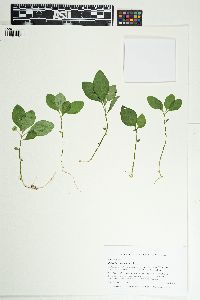Perennial herb 8 - 15 cm tall
Stem: creeping and spreading by rhizomes, with ascending flowering stems.
Leaves: alternate, with several scale-like (2 - 8 mm long) lower leaves scattered along the stem and three to six stalked, elliptic to oval leaves (1.5 - 4 cm long) crowded near the stem tip.
Flowers: borne one to four at end of stem, rose-purple to pink or white, with three small outer sepals and two inner petal-like sepals (wings) about the same length as the petals. The three petals are fused into a tube 1.3 - 2.3 cm long, and one petal is fringed. There are also a few self-pollinating flowers near the base that remain closed (cleistogamous).
Fruit: a dehiscent capsule, 6 mm long, nearly circular in outline, notched at the tip, with a three-lobed appendage (aril) attached to the seed.
Similar species: The other Polygala species with alternate leaves, Polygala incarnata, Polygala polygama, Polygala sanguinea, and Polygala senega, are taller with erect stems, and have flowers that are less than 11 mm long.
Flowering: mid to late May
Habitat and ecology: A very rare species found in the high dunes that has nearly been extirpated in the Chicago Region.
Occurence in the Chicago region: native
Etymology: Polygala comes from the Greek words polys, meaning much, and gala meaning milk, referring to the old belief that milkworts would aid in milk secretion. Paucifolia means sparse-leaved.
Author: The Morton Arboretum



